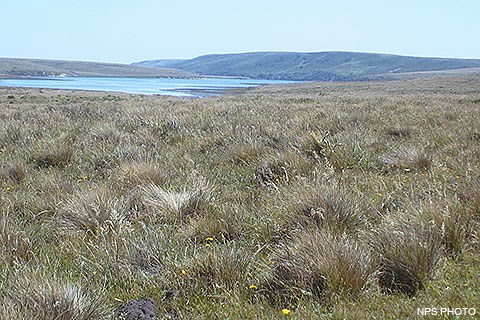|
Coastal grassland is used here to refer both to pristine coastal prairie and to non-native dominated grazed and ungrazed sites. Pristine coastal prairie is found in California from Santa Cruz County northward and generally within approximately 100 km from the coast. Native coastal grasslands are an endangered vegetation type in California; the state has lost 99% of its native grasslands overall and 90% of its northern coastal bunchgrass. Within PRNS, 80% of grasslands are dominated by non-native grasses (see Vegetation Map). Almost 20,000 acres of the Seashore is native or non-native grassland. Of this, approximately 75% is actively grazed by cattle. Native coastal prairie is dominated perennial bunchgrasses including tufted hairgrass (Deschampsia cespitosa), California oatgrass (Danthonia californica), meadow barley (Hordeum brachyantherum), California brome (Bromus carinatus) and Pacific reedgrass (Calamagrostis nutkaensis) among other species. Non-native grasslands are dominated by annual grasses, such as annual Italian wild rye (Lolium multiflorum), farmer’s foxtail (Hordeum murinum) and rattail fescue spp. (Vulpia spp.). Non-native perennial species are also common and are of management concern. These species include purple velvet grass (Holcus lanatus) and Harding grass (Phalaris aquatica). 
Coastal prairies have been greatly impacted since European settlement due to several factors including lack of fire, increased grazing and the introduction of non-natives. Native Americans likely burned grasslands in order to improve harvests of grains, tubers, and bulbs. This would have prevented many grasslands from succeeding to shrublands or forests. Coastal prairies have also been impacted by a combination of cattle grazing and the introduction of non-native annual grasses. These non-native species are strong competitors with the native-grasses, particularly in the context of intense grazing pressure. While coastal prairies probably burned frequently during Native American times, their fire ecology now must be considered in a different context due the presence of large numbers of non-native grasses. One study compared the effects of burning versus grazing in native coastal prairie systems and found that none of the three native grass species present on the site (D. californica, Nassella pulchra and Nassella lepida) were significantly affected by fire. Non-native annual grasses are disfavored by fire if burned in spring. Non-native annuals and perennial alike may be favored by fall burning and should be considered on a species by species basis. More information on the Coastal Grassland Plant Community. Text adapted from the Point Reyes National Seashore's Draft Wildland Fire Resource Advisor Guide (2,436 KB PDF).
|
Last updated: February 5, 2024
